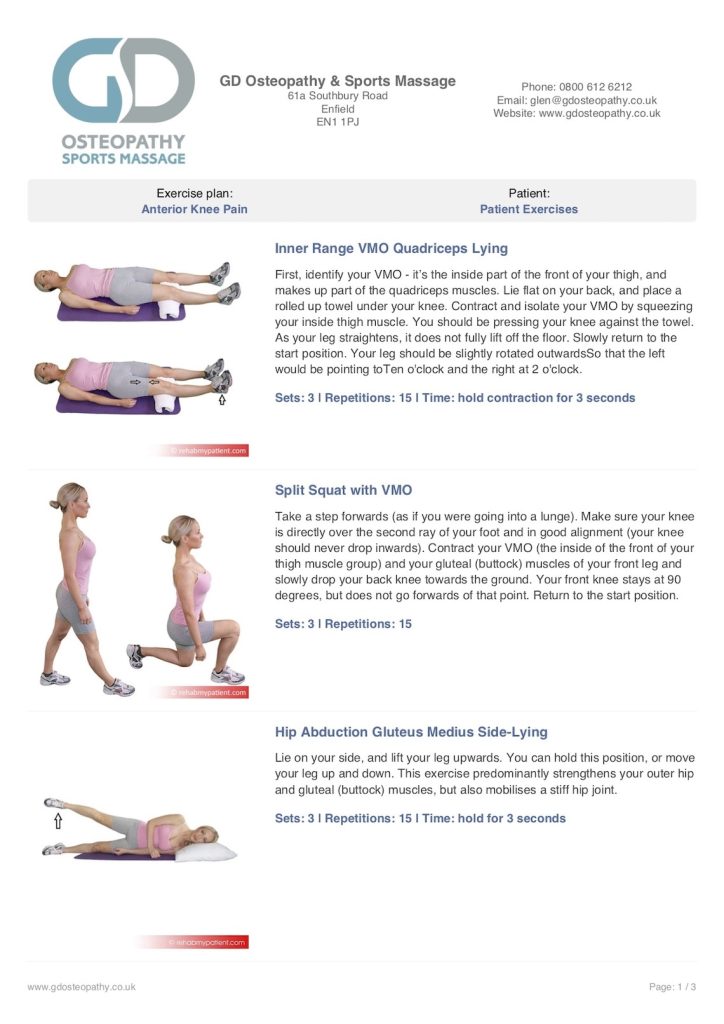Anterior Knee pain is a general term used to describe pain in the front of your knee. This may also be termed Anterior Knee Syndrome or Patellofemoral Pain Syndrome. The pain often originates from the joint between your knee cap and your thigh bone. The pain is due to physical and mechanical stress on your joint. If these stresses continue, it can cause damaged to the underlying joint cartilage. This damage is called Chondromalacia patellae, if this is not managed properly it can lead to osteoarthritis.
Symptoms
The most common symptom of anterior knee pain is a dull, ache in the front of the knee. The pain often begins gradually and can affect one or both sides. Other symptoms include:
- Pain during exercise and activities (walking up/down stairs, running, cycling, jumping, and squatting)
- Pain after sitting for a long period of time with your knees bent.
- Popping or crackling sounds when bending and straightening your knee.
Causes
Broadly speaking there are two main causes of anterior knee pain. Firstly overuse injuries, and secondly biomechanical issues.

Overuse
Overuse injuries happen due to repetitive stress and strain on the structures around the front of your knee. Being overweight, starting new activities or suddenly increasing the amount of sport you do can all cause anterior knee pain. When walking up or down stairs, the mechanical load that is placed on your knee is 3 to 4 times your body weight. So a 1 kg loss in bodyweight, is 3 to 4 kg less strain on your knee. When starting a new activity or sport it is important not to increase:
- Frequency: how often you do the activity.
- Time: how much time you spend doing the activity.
- Intensity: how physically demanding the activity is.
Not giving the body enough time to adapt, to repair and to get stronger will result in overuse.
Biomechanical
There are several biomechanical factors that have been shown to cause anterior knee pain. If you have knock knees, thigh bone twisting or flat feet – these could be contributing to your pain. Common muscular causes of anterior knee pain are due to:
- Weakness in the hip stabilisers and/or muscles of the thigh.
- Lack of flexibility in the muscles that surround and support the knee.
- Imbalance in the muscles around the knee.
- Muscle tension around the outside of the thigh.

Both boney and muscular problems can cause maltracking of the kneecap. The kneecap is the bone that sits within the tendon of the thigh muscles and glides over a groove on top of your thigh bone. Biomechanics and muscular imbalances pull the kneecap against this groove. The imbalance results in increased pressures between your kneecap and thigh bone surfaces and subsequent wear, inflammation and pain.
There are many other causes of anterior knee pain including plica, tendinitis, bursitis, fracture, dislocation and ligament sprain. As with all injuries, the correct diagnosis and treatment can make all the difference in speeding up your recovery
Treatment
As with all repetitive and biomechanical injuries, a break from the activity that has caused your injury is the single simplest thing you can do to speed recovery. You will probably have Inflammation around the structures in your knee. So applying ice to the area for 10-15 minutes a couple of times a day (especially after activity) will reduce both pain and inflammation.
If you are a runner, it is recommended that you undertake a biomechanical assessment of your running, when purchasing your next set of running shoes. For example, all the Runners World stores offer a video gait analysis service. A visit to a good osteopath or sports massage therapist, such as the Enfield Sports Massage clinic. Your therapist should focus on reducing muscle tension in tight muscles, while promoting strength in weak ones. Your practitioner may also apply taping or strapping to your knee, to help further recovery.

Home exercises are another great way to speed up the healing process. The muscles on the inside of your thighs (VMO), are very important for the control of movement (tracking) of your knee cap. Exercises to strengthen the VMO along with stretches to reduce any tension in your glutes and muscles on the outside of your thigh will help to balance the forces around the knee. Also stability exercises will help to stabilise through the ankle, knee and hip. See our Anterior Knee Pain Exercise Program for our recommendations.

